Shibuya, Tokyo
| Shibuya 渋谷 |
|||
|---|---|---|---|
| — Special ward — | |||
| 渋谷区 · Shibuya City | |||
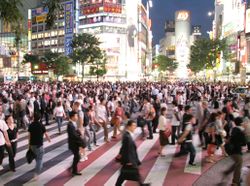 |
|||
|
|||
 |
|||
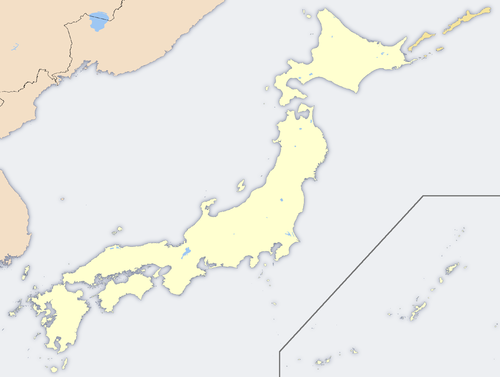 Shibuya
|
|||
| Coordinates: | |||
| Country | Japan | ||
| Region | Kantō | ||
| Prefecture | Tokyo | ||
| Government | |||
| - Mayor | Toshitake Kuwahara | ||
| Area | |||
| - Total | 15.11 km2 (5.8 sq mi) | ||
| Population (2008) | |||
| - Total | 208,371 | ||
| - Density | 13,540/km2 (35,068.4/sq mi) | ||
| Time zone | Japan Standard Time (UTC+9) | ||
| Website | Shibuya | ||
Shibuya (渋谷区 Shibuya-ku) is one of the 23 special wards of Tokyo, Japan. As of 2008, it had an estimated population of 208,371 and a density of 13,540 persons per km². The total area is 15.11 km².
The name "Shibuya" is also used to refer to the central business district of Shibuya Ward, which surrounds Shibuya Station, one of Tokyo's busiest railway stations. Shibuya is known as one of the fashion centers of Japan, particularly for young people, and as a major nightlife area.
Contents |
History

Following the opening of the Yamanote Line in 1885, Shibuya began to emerge as a railway terminal for southwestern Tokyo and eventually as a major commercial and entertainment center. It was incorporated as a village in 1889, as a town in 1909, as a ward of Tokyo City in 1932, and as a ward of Tokyo Metropolis in 1943. The present-day special ward was established on March 15, 1947.
One of the most well-known stories concerning Shibuya is the story of Hachikō, a dog who waited on his late master at Shibuya Station every day from 1923 to 1935, eventually becoming a national celebrity for his loyalty. A statue of Hachikō was built adjacent to the station, and the surrounding Hachikō Square is now the most popular meeting point in the area.
Yoyogi Park in Shibuya was one of the main venues for the 1964 Summer Olympics.
In 1965, 18-year-old Misao Katagiri, who had already shot and killed a policeman, went on a shooting rampage, and injured 16 more people. He was sentenced to death and was executed by hanging in 1972.
Shibuya has achieved great popularity among young people in the last 30 years. There are several famous fashion department stores in Shibuya. Shibuya 109 is a major shopping center near Shibuya Station, particularly famous as the origin of the kogal subculture. Called "Ichi-Maru-kyū," which translates as 1–0–9 in Japanese, the name is actually a pun on that of the corporation that owns it — Tokyu (which sounds like 10–9 in Japanese). The contemporary fashion scene in Shibuya extends northward from Shibuya Station to Harajuku, where youth culture reigns; Omotesandō, the zelkova tree- and fashion brand-lined street; and Sendagaya, Tokyo's apparel design district.
During the late 1990s, Shibuya also became known as the center of the IT industry in Japan. It was often called "Bit Valley" in English, a pun on "Bitter Valley," the literal translation of "Shibuya."
Geography
Shibuya includes many well-known commercial and residential districts such as Daikanyama, Ebisu, Harajuku, Hiroo, Higashi, Omotesandō, Sendagaya, and Yoyogi.
Districts
- Hatagaya
- Sasazuka, Hatagaya, Honmachi
- Yoyogi
- Uehara, Ōyamachō, Nishihara, Hatsudai, Motoyoyogichō, Tomigaya, Yoyogi-kamizonochō
- Sendagaya
- Sendagaya, Jingūmae
- Ebisu-Ōmukai
- Kamiyamachō, Jinnan, Udagawachō, Shōtō, Shinsenchō, Maruyamachō, Dōgenzaka, Nanpeidaichō, Sakuragaokachō, Hachiyamachō, Uguisudanichō, Sarugakuchō, Daikan'yamachō, Ebisunishi, Ebisuminami
- Hikawa-Shimbashi
- Shibuya, Higashi, Ebisu, Hiroo
Politics and government
Shibuya is run by a city assembly of 34 elected members. The current mayor is Toshitake Kuwahara, an independent backed by the Liberal Democratic Party and Komeito.
Elections
- Shibuya mayoral election, 2003
Sightseeing and historic sites
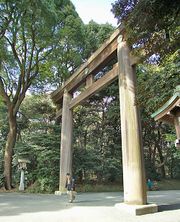
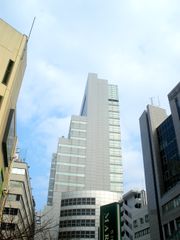

Green areas
- Meiji Shrine, Shinto shrine dedicated to the souls of Emperor Meiji and Empress Shōken, surrounded by a 700,000-square-meter forest.
- Shinjuku Gyoen (Sendagaya), former Imperial gardens now open to the public as a park.
- Yoyogi Park, once a training base for the Imperial Japanese Army, later the Washington Heights housing area for the Occupation of Japan, then the lodgings for contestants in the Tokyo Olympics.
Buildings
- Shibuya 109, a popular and trendy place for mostly Japanese young women to shop.
- Bunkamura, theatre and concert hall complex
- Cerulean Tower, the tallest building in the Shibuya Station area
- Yebisu Garden Place (Ebisu), site of the former Sapporo Brewery, now featuring restaurants and shopping, along with the Westin Hotel
- National Noh Theatre (Sendagaya)
- New National Theatre (Hatsudai), site of opera, ballet, and other performances
- NHK Broadcasting Center, headquarters of the NHK radio, television, and satellite broadcasting system
- NTT Docomo Yoyogi Building, the third-tallest building in Tokyo, patterned after the Empire State Building
- Omotesandō Hills, a shopping mall completed in 2006
- Southern Terrace (Sendagaya)
- Takashimaya Times Square (Sendagaya), one of the largest department stores in Japan
- Tokyo Metropolitan Gymnasium (Sendagaya), a major indoor arena complex
- Tokyo Baptist Church
- Yoyogi National Gymnasium, designed for the 1964 Olympics by Kenzo Tange.
Streets and places
- Aoyama Dōri, a major east-west thoroughfare
- Center Gai
- Dōgen-zaka, a road in central Shibuya famous for its surrounding nightclubs and love hotels
- Komazawa Dōri – running past Daikanyama, down the hill to Ebisu, crossing Meiji Dōri and up the hill through Higashi, Tokyo and Hiroo . The road stops at the Shuto expressway in Minami Aoyama. Famed for its beautiful trees that turn bright yellow in autumn, cafes, restaurants and large replica of Michelangelo's David outside of the Papas building. Prince Hitachi and Princess Hitachi have their official residence in a palace in large gardens off Komazawadori in Higashi [1]
- Kōen Street, in central Shibuya between Shibuya Station and Yoyogi Park
- Meiji Dōri, a major north-south thoroughfare parallel to the Yamanote Line
- Miyamasu-zaka
- Omotesandō, an avenue leading up to the Meiji Shrine with a number of famous-brand boutiques
- Spain-zaka
- Takeshita Street, a shopping street through Harajuku
- Yamanote Street
- Shibuya
- Ebisu
- Harajuku
- Hiroo
- Sendagaya
- Yoyogi
Other
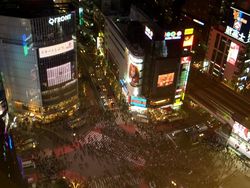
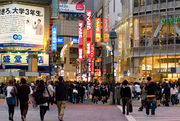

- Shibuya is famous for its scramble crossing. It is located in front of the Shibuya Station Hachikō exit and stops vehicles in all directions to allow pedestrians to inundate the entire intersection. Three large TV screens mounted on nearby buildings overlook the crossing. The Starbucks store overlooking the crossing is also one of the busiest in the world.
- On the northwest side of Shibuya station, there is a popular meeting place with a statue of Hachikō, while on the northeast side of Shibuya station there is another popular meeting place with a statue called "Moyai". The statue resembles a Moai statue, and it was given to Shibuya by the people of Niijima Island in 1980.
Transportation
Rail
The main station in Shibuya is Shibuya Station.
- JR East
- Yamanote Line: Yoyogi, Harajuku, Shibuya, Ebisu stations
- Chūō Line: Yoyogi, Sendagaya stations
- Saikyō Line, Shōnan-Shinjuku Line: Shinjuku (the part south of Kōshū Kaidō, including the New South Entrance, is in Shibuya), Shibuya, Ebisu
- Tokyo Metro
- Ginza Line: Shibuya Station
- Hibiya Line: Ebisu Station
- Chiyoda Line: Meiji Jingūmae, Yoyogi Kōen, Yoyogi Uehara stations
- Hanzōmon Line: Shibuya Station
- Fukutoshin Line: Shibuya, Meiji Jingūmae, Kitasandō stations
- Tokyo Metropolitan Bureau of Transportation Toei Ōedo Line: Shinjuku (in Yoyogi), Yoyogi, Kokuritsu Kyogi-jo stations
- Tokyu Corporation (Tōkyū)
- Tōyōko Line: Shibuya, Daikanyama stations
- Den-en-toshi Line: Shibuya, Ikejiri Ohashi stations
- Keiō
- Inokashira Line: Shibuya, Shinsen
- Keiō Line: Sasazuka Station
- Keiō New Line: Hatsudai, Hatagaya, Sasazuka stations
- Odakyū Odawara Line: Minami Shinjuku, Sangubashi, Yoyogi Hachiman, Yoyogi Uehara stations
- The Royal Platform (kyūtei hōmu), used by the Japanese Imperial Family on rare occasions, is located along the Yamanote Line, a few minutes walk from Harajuku Station in Sendagaya 3-chome.
Highway
- Shuto Expressway
- No.3 Shibuya Route (Tanimachi JCT – Yoga)
- No.4 Shinjuku Route (Miyakezaka JCT – Takaido)
- National highways
- Route 20, the Kōshū Kaidō
- Route 246, with the local names Aoyama-dōri and Tamagawa-dōri
Economy

Several companies are headquartered in Shibuya.
Calpis,[2] Casio,[3] and Tokyu Corporation have their headquarters in Shibuya.[4] East Japan Railway Company has its headquarters in Yoyogi, Shibuya.[5] 81 Produce has its headquarters in Tomigaya, Shibuya.[6][7]
Google's Japan headquarters are in Shibuya.[8] Campbells Soup's Japan division is headquartered in Shibuya.[9] The ABB Group's Japan headquarters are located in Shibuya.[10][11] Virgin Atlantic Airways's Japan office is on the sixth floor of the POLA Ebisu Building in Shibuya.[12]
Former operations
At one time Smilesoft had its headquarters in Shibuya.[13] In May 1985 the headquarters of Bandai Visual moved to Shibuya. In March 1990 the headquarters moved to Shinjuku, Shinjuku, Tokyo.[14] A.D. Vision - Tokyo, Y.K., the Japanese subsidiary of A.D. Vision, was in Shibuya.[15]
Companies
- Amway Japan: Japan headquarters for Amway a multi-level marketing company
- Coca-Cola Japan
- Cyber Agent Ltd.: Internet advertising agency
- East Japan Railway Company (JR East) (Yoyogi)
- Gap Japan
- GlaxoSmithKline
- Ito En Ltd.: Bottler of tea, coffee, vegetable drinks and other beverages
- Kentucky Fried Chicken Japan Ltd.
- Microsoft Japan
- NHK (Nippon Hoso Kyokai) (NHK Broadcasting Center)
- Nippon Crown Records Co., Ltd.: a Japanese record label company
- PPG: Manufacturer of industrial coatings
- Papas: a clothing, cafe and bakery company, headquartered on Komazawadori in the neighbourhood of Higashi
- Sapporo Breweries Limited
- Square Enix: video game, manga producer
- Teichiku Records: record label
- Trend Micro Japan: security software company
- Jupiter: video game industry
Education
Colleges and universities
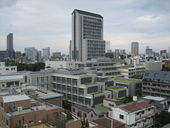
- Aoyama Gakuin University
- Bunka Women's University (Yoyogi)
- Jissen Women's University
- Kokugakuin University (Higashi, Tokyo)
- University of the Sacred Heart (Hiroo)
- Tokai University
Primary and secondary schools
Shibuya operates public elementary and middle schools, while Tokyo Metropolitan Government Board of Education operates public high schools.
- Aoyama High School
- First Commercial High School
- Hiroo High School
Public libraries
Shibuya operates several public libraries, including the Central Library, the Nishihara Library, the Shibuya Library, the Tomigaya Library, the Sasazuka Library, the Honmachi Library, and the Rinsen Library. In addition, the Yoyogi Youth Hall houses the Yoyogi Library Room.[16]
Gallery
 Shibuya 109 at dusk |
 Shopping near Shibuya Station |
 The Statue of Moyai, a gift from the people of Niijima |
See also
- List of leading shopping streets and districts by city
- Love Hotel Hill
References
- ↑ Kunaicho |The Imperial Palace and other Imperial Household Establishments
- ↑ "Company Outline." Calpis. Retrieved on February 12, 2010.
- ↑ "Corporate." Casio. Retrieved on February 25, 2009
- ↑ "会社概要." Tokyu Corporation. Retrieved on November 27, 2009.
- ↑ East Japan Railway Company. "JR East Corporate Data". http://www.jreast.co.jp/e/data/index.html. Retrieved 20 June 2009.(English)
- ↑ "株式会社81プロデュース 会社概要." 81 Produce. Retrieved on April 5, 2010.
- ↑ "株式会社81プロデュース アクセスマップ." 81 Produce. Retrieved on April 5, 2010.
- ↑ "Google Offices." Google. Retrieved on July 12, 2009.
- ↑ "Profile." Campbells Soup Japan. Retrieved on November 10, 2008.
- ↑ "Addresses in Japan." ABB Group. Retrieved on February 6, 2009.
- ↑ "Tokyo (26-1 Sakuragaoka-cho)." ABB Group. Retrieved on February 6, 2009.
- ↑ "Japan Office." Virgin Atlantic Airways. Retrieved on 14 December 2009.
- ↑ "会社概要." Smilesoft. February 12, 2002. Retrieved on February 11, 2010.
- ↑ "History." Bandai Visual. Retrieved on March 16, 2010.
- ↑ "Contact ADV." A.D. Vision. Retrieved on May 8, 2009.
- ↑ http://www.city.shibuya.tokyo.jp/eng/living/library.html
External links
- Shibuya official website in English
- Wikitravel Tokyo/Shibuya
|
|||||||||||||||||
|
|||||||||||||||||||
|
|||||
